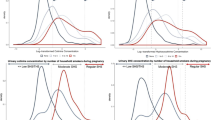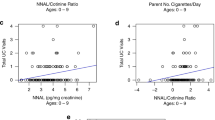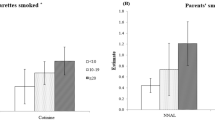Abstract
Altered behavior due to prenatal smoke exposure was examined in 25 neonates born from smoking mothers who consumed at least 5 cigarettes/d during the entire gestation. Data were compared with 25 matched neonates born from nonsmoking mothers. Neonatal behavior was evaluated using the Brazelton Neonatal Behavioral Assessment Scale (BNBAS). Antenatal exposure to tobacco smoke at the end of the pregnancy was determined by measurement of urinary cotinine. Newborns from smoking mothers showed significant lower scores in various BNBAS items compared with neonates from nonsmoking mothers. A strong correlation was observed between infant irritability and urinary cotinine in newborns from smoker and nonsmoking mothers and with number of daily smoked cigarettes and maternal nicotine daily intake of infants exposed to active maternal smoking. Linear regression analysis showed that urinary cotinine was the best predictor of infant irritability (r2 = 0.727). The latter was also associated to the neonate's low level of attention and poor response to inanimate auditory stimuli. Among infants from nonsmoking mothers, paternal smoking significantly correlated with infant urinary cotinine and infant irritability, being also the best predictor of irritability (r2 = 0.364). Neonatal behavior can be significantly altered in a dose-dependent manner even after modest prenatal exposure to tobacco smoke.
Similar content being viewed by others
Log in or create a free account to read this content
Gain free access to this article, as well as selected content from this journal and more on nature.com
or
Abbreviations
- BNBAS:
-
Brazelton Neonatal Behavioral Assessment Scale
References
Hoyert DL, Mathews TJ, Menacker F, Strobino DM, Guyer B 2006 Annual summary of vital statistics: 2004. Pediatrics 117: 168–183
Lester BM, Tronick EZ, LaGasse L, Seifer R, Bauer CR, Shankaran S, Bada HS, Wright LL, Smeriglio VL, Lu J, Finnegan LP, Maza PL 2002 The maternal lifestyle study: effects of substance exposure during pregnancy on neurodevelopmental outcome in 1-month-old infants. Pediatrics 110: 1182–1192
Centers for Disease Control and Prevention 2004 Smoking during pregnancy - United States - 1990–2002. MMWR Morb Mortal Wkly Rep 53: 911–915
Chatenoud L, Chiaffarino F, Parazzini F, Benzi G, La Vecchia C 1999 Prevalence of smoking among pregnant women is lower in Italy than England. BMJ 318: 1012
Pichini S, García-Algar O 2006 In utero exposure to smoking and newborn neurobehavior: how to assess neonatal withdrawal syndrome?. Ther Drug Monit 28: 288–290
Bush PG, Mayhew TM, Abramovich DR 2000 Maternal cigarette smoking and oxygen diffusion across the placenta. Placenta 21: 824–833
Garcia-Algar O, Puig C, Mendez C, Vall O, Pacifici R, Pichini S 2001 Neonatal nicotine withdrawal syndrome. J Epidemiol Community Health 55: 687–688
Godding V, Bonnier C, Fiasse L, Michel M, Longueville E, Lebecque P, Robert A, Galanti L 2004 Does in utero exposure to heavy maternal smoking induce nicotine withdrawal symptoms in neonates?. Pediatr Res 55: 645–651
Andres RL, Day MC 2000 Perinatal complications associated with maternal tobacco use. Semin Neonatol 5: 231–241
Law KL, Stroud LR, LaGasse LL, Niaura R, Liu J, Lester BM 2003 Smoking during pregnancy and newborn neurobehavior. Pediatrics 111: 1318–1323
Pichini S, Basagaña X, Pacifici R, Garcia O, Puig C, Vall O, Harris J, Zuccaro P, Segura J, Sunyer J 2000 Cord serum cotinine as a biomarker of foetal exposure to cigarette smoke at the end of pregnancy. Environ Health Perspect 108: 1079–1083
Garcia-Algar O, Puig C, Vall O, Pacifici R, Pichini S 2004 Effects of maternal smoking during pregnancy on newborn neurobehavior: neonatal nicotine withdrawal syndrome. Pediatrics 113: 623–624
Eliopoulos C, Klein J, Phan MK, Knie B, Greenwald M, Chitayat D, Koren G 1994 Hair concentrations of nicotine and cotinine in women and their newborn infants. JAMA 271: 621–623
Pichini S, Garcia-Algar Ó, Muñoz L, Vall O, Pacifici R, Figueroa C, Pascual JA, Diaz D, Sunyer J 2003 Assessment of chronic exposure to cigarette smoke and its change during pregnancy by segmental analysis of maternal hair nicotine. J Expo Anal Environ Epidemiol 13: 144–151
Klein J, Blanchette P, Koren G 2004 Assessing nicotine metabolism in pregnancy–a novel approach using hair analysis. Forensic Sci Int 145: 191–194
Paludetto R, Mansi G, Raimondi F, Romano A, Crivaro V, Bussi M, D'Ambrosio G 2002 Moderate hyperbilirubinemia induces a transient alteration of neonatal behavior. Pediatrics 110: E50
Mansi G, De Maio C, Araimo G, Rotta I, Crivaro V, Sarno M, Raimondi F, Paludetto R 2003 Safe" hyperbilirubinemia is associated with altered neonatal behavior. Biol Neonate 83: 19–21
Van Vunakis H, Gjika HB, Langone J 1993 Radioimmunoassays for nicotine and cotinine. IARC Sci Publ 109: 293–299
Zuccaro P, Altieri I, Rosa M, Pellegrini M, Pacifici R 1997 Interference of nicotine metabolites in cotinine determination by RIA. Clin Chem 43: 180–181
Brazelton TB, Nugent JK 1995 Neonatal Behavioral Assessment Scale. 3rd edition, Cambridge University Press, Cambridge
Jacobson SW, Fein GG, Jacobson JL, Schwartz PM, Dowler JK 1984 Neonatal correlates of prenatal exposure to smoking, caffeine and alcohol. Infant Behav Dev 7: 253–265
Richardson GA, Day NL, Taylor PM 1989 The effect of prenatal alcohol, marijuana, and tobacco exposure on neonatal behavior. Infant Behav Dev 12: 199–209
Saxton DW 1978 The behavior of infants whose mothers smoke in pregnancy. Early Hum Dev 2: 363–369
Oyemade UJ, Cole OJ, Johnson AA, Knight EM, Westney OE, Laryea H, Hill G, Cannon E, Fomufod A, Westney LS, Jones S, Edwards CH 1994 Prenatal substance abuse and pregnancy outcomes among African American women. J Nutr 124: 994S–999S
Fried PA, Makin JE 1987 Neonatal behavioral correlates of prenatal exposure to marijuana, cigarettes and alcohol in a low risk population. Neurotoxicol Teratol 9: 1–7
Lambers DS 1996 The maternal and foetal physiologic effects of nicotine. Semin Perinatol 20: 115–126
Acknowledgements
The authors thank the mothers and the nursing staff of the Division of Neonatology of the University of Naples “Federico II” at for their efficient help, and Dr. Marta Pulido for manuscript editing.
Author information
Authors and Affiliations
Corresponding author
Additional information
Supported by: The Dipartimento Nazionale per le politiche antidroga della Presidenza del Consiglio dei Ministri (S.P., R.P., P.Z., Ó.G.-A.).
Rights and permissions
About this article
Cite this article
Mansi, G., Raimondi, F., Pichini, S. et al. Neonatal Urinary Cotinine Correlates With Behavioral Alterations in Newborns Prenatally Exposed to Tobacco Smoke. Pediatr Res 61, 257–261 (2007). https://doi.org/10.1203/pdr.0b013e31802d89eb
Received:
Accepted:
Issue date:
DOI: https://doi.org/10.1203/pdr.0b013e31802d89eb
This article is cited by
-
Maternal smoking during pregnancy and offspring overweight: is there a dose–response relationship? An individual patient data meta-analysis
International Journal of Obesity (2018)
-
Exposure to paternal tobacco smoking increased child hospitalization for lower respiratory infections but not for other diseases in Vietnam
Scientific Reports (2017)
-
Developmental Consequences of Fetal Exposure to Drugs: What We Know and What We Still Must Learn
Neuropsychopharmacology (2015)
-
Impact of low-level gestational exposure to organophosphate pesticides on neurobehavior in early infancy: a prospective study
Environmental Health (2013)
-
Long-term Effects of Prenatal Cigarette Smoke Exposure on Behavior Dysregulation Among 14-Year-Old Offspring of Teenage Mothers
Maternal and Child Health Journal (2012)



